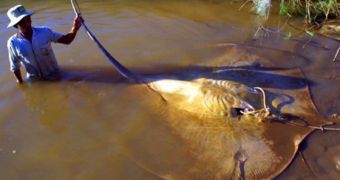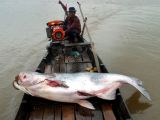The Loch Ness monster has been stirring people's fantasy for so long. But instead of looking for an imaginary monster, people should take care of the real documented monster from lakes and rivers.
One could be already doomed: the Three Gorges Dam could have decided the faith of the Chinese paddle fish: a monster believed to reach lengths of 23 feet (7 meters) and weights of 500 kg (even if recorded data speaks about 3.5 m (12 ft) in length and 300 kg in weight). None has been caught in its habitat, Yangtze River, since 2003.
"From the point of view of the fish, there's nothing worse than a dam. Dams block upstream migration, destroy spawning habitat, and can turn large stretches of river into ecological wastelands." said Zeb Hogan, a fisheries biologist with the University of Reno, in Nevada, who earlier this year launched the Megafishes Project, a three-year effort funded by the National Geographic Society to assess the current state of the world's 20-some species of giant freshwater fish.
Megafishes are "the real-life Loch Ness monsters and Bigfoots of the aquatic world." said Hogan.
Mekong giant catfish can reach 3 m (10 ft) in length and be 350 kg (780 pounds) and arapaima of the Amazon can be 4.5 m (15 ft) long. The giant freshwater stingray, which lives in the Mekong River (southeast Asia) can reach 197 inches (500 centimeters) in length, 1,323 pounds (600 kilograms) in weight, and have a body diameter of 95 inches (240 centimeters). "Everywhere around the world these large fish are in big trouble. In many places they're now so rare that the opportunity for documentation and study may soon be lost. The troubled story of the world's giant freshwater fish underlines the environmental crisis facing many rivers and lakes," Hogan said.
"The world's fresh waters are experiencing declines in biodiversity far greater than those seen in the oceans or on land," he pointed out.
Rivers and lakes make up only 0.01 % of Earth's water, but they harbor 8 % of all species and 40 % of the fish species of the planet. "But more than 20 % of the world's known freshwater fish species have become extinct or gravely threatened in recent years. The conservation of freshwater biodiversity traditionally receives low priority, partially because people think of fish as food, not as wild animals," said Hogan.
"In terms of helping people to understand the special importance or uniqueness of a region, it is usually easiest to identify some flagship species that capture people's attention," said Ian Harrison, a fish biologist at the American Museum of Natural History in New York. "But the project isn't just about finding the world's largest fish. It's about healthy aquatic habitats, clean drinking water, living rivers. These are things that we all rely on every day.", said Hogan.
The dangers haunting the huge freshwater fishes vary from pollution and high boat traffic to overfishing, habitat fragmentation from dams, climate change, and exotic invasive species. Many of them require many years to mature, fact that turns them particularly vulnerable to environmental threats and changes. Moreover, unlike marine creatures, these species often live near dense human populations.
About ten Chinese sturgeon get killed or severely injured annually by boat propellers on the Yangtze River, with the most cargo ship traffic of any river.
"Compounding the problem is the [inadequate] system of governance for many inland waters. Many of the world's large rivers cross one or more national borders, but fish or pollution don't respect these borders, so actions in one part of the river affect fish elsewhere." said Devin Bartley, a fisheries specialist with the United Nation's Food and Agriculture Organization in Rome, Italy.
In Mekong, the overfishing of the giant catfish, made the capture of the species drop from hundreds annually to just one in 2006. "One of the most immediate threats facing megafishes is that they're so poorly understood. In the ocean we have already lost most of the apex predators and other large fish, but at least their plight has received a lot of attention. These freshwater giants are even more threatened because of their much narrower ranges and because we know so little about them, making them much harder to protect. Megafish in the ocean are known to play crucial ecological roles, but we have no idea of what the ecological consequences might be for rivers and lakes that are missing these giants," said Nancy Knowlton, director of the Center for Marine Biology and Conservation at the University of California, San Diego.
"Due to the precarious state of populations of large freshwater fish, this new project is a race against the clock. We must identify and protect these aquatic giants before they are gone forever.", Hogan said.

 14 DAY TRIAL //
14 DAY TRIAL // 


